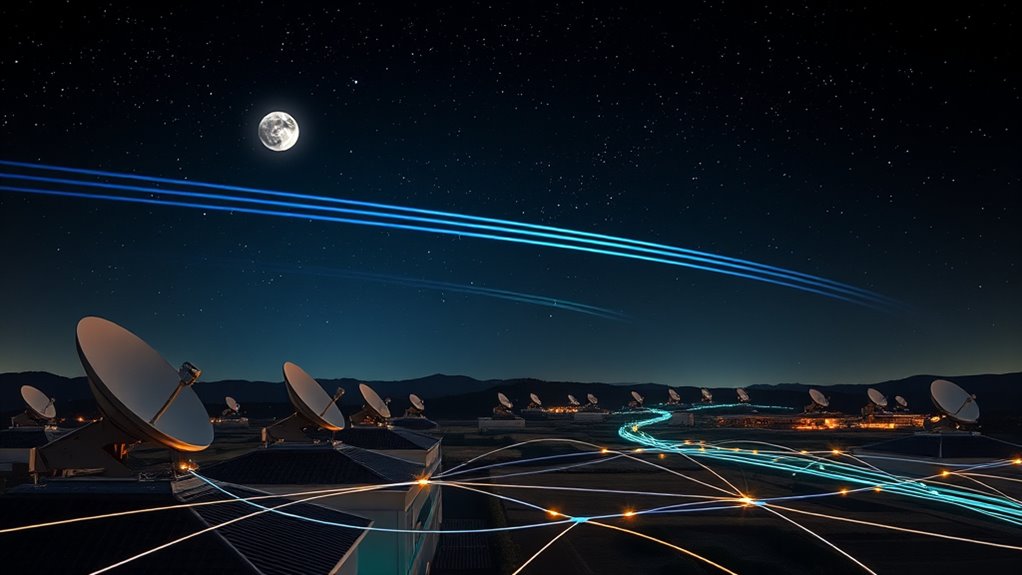By 2025, satellite internet will transform how you connect by offering fast, reliable broadband access across urban and remote areas. You’ll experience smoother streaming, quicker downloads, and stable video calls, even in isolated communities. This technology will complement existing networks, ensuring you stay connected during outages or emergencies. If you want to see how this innovative connectivity will impact your world and beyond, keep exploring what’s coming next.
Key Takeaways
- Satellite internet will significantly expand global connectivity, especially in remote and underserved regions by 2025.
- Low Earth orbit (LEO) satellites will reduce latency and increase speeds, improving service quality for users worldwide.
- Integration with fiber and 5G networks will create a resilient, multi-layered infrastructure supporting urban and rural areas.
- Costs decreasing and technological advancements will make satellite broadband more accessible and affordable for diverse populations.
- Enhanced satellite connectivity will boost economic growth, healthcare, education, and social inclusion across the globe.

By 2025, satellite internet and broadband are set to transform connectivity worldwide, especially in remote and underserved areas. This technological leap isn’t just about faster speeds; it’s about bridging the gap between urban connectivity and rural expansion, guaranteeing everyone has access to reliable internet. In cities, satellite broadband will complement existing fiber and 5G networks, reducing congestion and providing backup options during outages. You’ll notice smoother streaming, quicker downloads, and more stable video calls, even during peak hours. For urban dwellers, satellite internet becomes an essential part of a resilient, multi-layered connectivity infrastructure that keeps everything running seamlessly.
Meanwhile, rural expansion will see perhaps the most dramatic change. In areas where laying fiber optics is economically unfeasible or physically challenging, satellite broadband offers a practical alternative. You might live miles from the nearest town, yet still enjoy high-speed internet that supports remote work, telemedicine, online education, and agriculture technology. This expansion isn’t just about convenience; it’s about economic growth, better healthcare, and educational opportunities for communities that once struggled with limited connectivity. Satellite companies are deploying constellations of low Earth orbit (LEO) satellites, which provide lower latency and higher speeds than traditional geostationary satellites. This means you won’t have to compromise on performance just because you’re in a rural area.
The integration of satellite broadband into existing networks will also enable smarter cities and more connected rural communities. In urban areas, satellite links can guarantee that infrastructure remains online during natural disasters or network overloads, maintaining essential services. For rural communities, satellite internet becomes a lifeline, connecting farms, schools, and healthcare facilities to the broader digital economy. You’ll see more rural homes getting reliable, high-speed internet without the need for expensive cable or fiber installation. This democratization of access will foster innovation and social inclusion, allowing people to participate fully in the digital age regardless of where they live. Additionally, advances in satellite technology will continue to improve service quality and affordability for all users.
As the technology advances, the cost of satellite internet will continue to decrease, making it more accessible to everyone. You’ll have options that fit different budgets and needs, from basic connectivity for streaming and browsing to enterprise-level solutions for businesses. The goal is to create a more equitable digital landscape where connectivity isn’t determined by geography. By 2025, satellite internet and broadband will truly connect the world, shrinking distances and opening up new opportunities for all, from bustling cities to the most remote villages.
Frequently Asked Questions
How Will Satellite Internet Impact Global Digital Equity?
Satellite internet will markedly boost global digital equity by enhancing digital inclusion and rural connectivity. You’ll find remote areas gaining reliable, high-speed internet access, bridging the digital divide. This technology allows underserved communities to access education, healthcare, and economic opportunities. As satellite networks expand, more people will be empowered to participate fully in the digital world, making connectivity more equitable and inclusive worldwide.
What Are the Environmental Effects of Increased Satellite Launches?
Ever wondered about the environmental toll? Increased satellite launches can lead to more space debris, cluttering Earth’s orbit and risking collisions. They also contribute to atmospheric pollution during rocket launches, releasing gases that can harm the environment. Are we risking long-term space and Earth health for better connectivity? While satellite tech offers benefits, it’s essential to take into account these environmental effects and develop sustainable launch practices.
How Secure Is Satellite Internet Against Cyber Threats?
Satellite internet security depends on robust encryption protocols, which protect your data from cyber vulnerabilities. While these protocols substantially reduce risks, no system is entirely invulnerable. You should stay vigilant by using strong passwords and updating firmware regularly. Cyber attackers might target satellite networks, but ongoing advancements in security measures help safeguard your connection. Overall, satellite internet is fairly secure when proper security practices are in place.
Will Satellite Broadband Replace Traditional Fiber Networks Entirely?
No, satellite broadband won’t completely replace traditional fiber networks. While satellite internet offers global coverage and quick deployment, fiber optics provide unmatched signal stability and ultra-fast speeds. You’ll continue to rely on fiber for high-demand, stable connections, especially in urban areas. Satellite technology will complement fiber, expanding access in remote regions. Together, they’ll create a resilient, interconnected network that meets your diverse needs for speed and reliability.
How Will Satellite Latency Improvements Affect Real-Time Applications?
Latencies will drop markedly, making satellite internet more suitable for real-time applications like gaming. With latency reduction, you’ll notice less lag and smoother gameplay, rivaling fiber connections. This improvement means you can enjoy real-time gaming, video calls, and live streaming without frustrating delays. As satellite tech advances, you’ll experience faster, more reliable internet, narrowing the gap between satellite and traditional broadband, especially for activities demanding quick responses.
Conclusion
As you look ahead to 2025, the promise of satellite internet and broadband remains tantalizingly close yet uncertain. Will these advances truly bridge the digital divide, or will unforeseen hurdles emerge? The journey toward seamless connectivity isn’t over, and the next few years could redefine how the world stays connected. Stay tuned—what happens next could change everything, reshaping our digital future in ways we can only begin to imagine.









